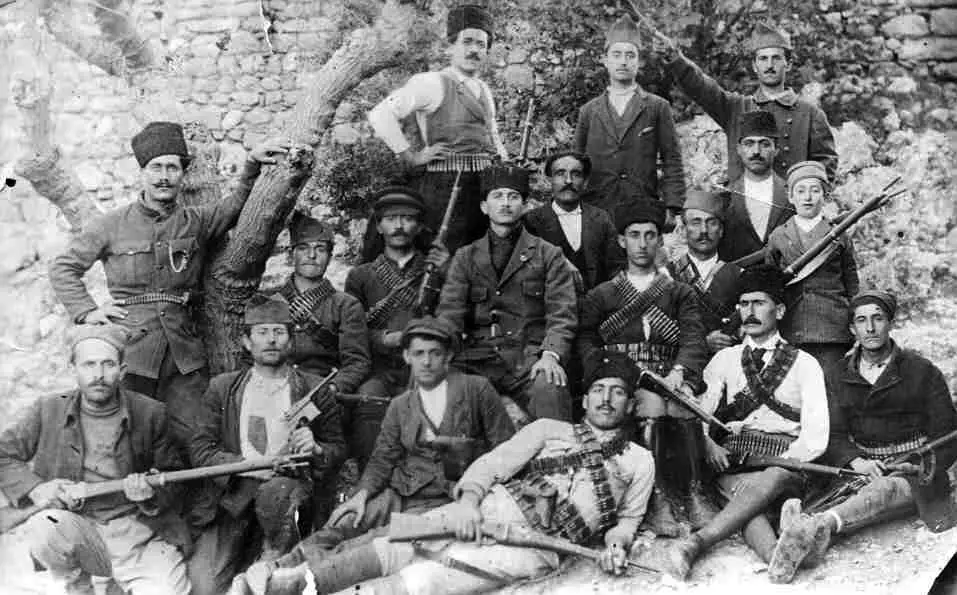The Battle of Sardarabad (Armenian: Սարդարապատի ճակատամարտ) was a battle of the Caucasus Campaign of World War I that took place near Sardarabad, Armenia from May 21 to May 24, 1918.
Sardarabad was only 40 kilometers west of the city of Yerevan and the battle is currently seen as not only stopping the Turkish advance into the rest of Armenia but also preventing the complete destruction of the Armenian nation.
Tovmas Nazarbekyan
Sardarabad Battle Commanders
Movses Silikyan
Daniel Bek-Pirumyan
Poghos Bek-Pirumyan
Kristapor Araratyan
Turkish Transcaucasian Dream and Armenia
Just two months after the Treaty of Brest-Litovsk was signed, the Ottoman Empire attacked what had been Russian-Armenian territory. In violation of the Brest-Litovsk Peace Treaty with the Russians, elements of the Fourth Army crossed the border in May 1918 and attacked Alexandropol (modern-day Gyumri).
The Ottoman Army intended to crush Armenia and seize Transcaucasia.
At that time, only a small area of historical Armenian territory which used to be a part of the Russian Empire remained unconquered by the Ottoman Empire, and into that area, hundreds of thousands of Armenian refugees had fled after the Armenian Genocide.
The Ottoman Forces began a three-pronged attack in an attempt to conquer Armenia. When Alexandropol fell, the Ottoman Army moved into the Ararat Valley the heart of Armenia.
Armenians summoned by Aram Manougian and under the orders of Major General Movses, Silikyan defeated the Ottoman troops in a three-day battle at Sardarabad as well as Abaran and Karakilisa.
Video Documentary of Sardarabad Battle and Modern-Day Battles
Armenian Clergymen on the battlefield
His Holiness Gevorg V was asked to leave Saint Etchmiatsin and move to the Sevan Lake island monastery, he came out to the people standing in the Cathedral courtyard. He said he would not leave the mother church of all Armenian churches inherited from our ancestors.
“If the Armenian army and people cannot stop the enemy, cannot save our sanctuaries, then I am ready to die right now, here, at the threshold of our temple, as your spiritual father. And if the end has come, then why not die honorably and bravely, not crawling in front of the enemy.”
The Catholicos, deeply saddened by the suffering of his people, ordered the bells of the mother church in Etchmiadzin as well as the bells of all Armenian churches around the country to ring all day, calling his people to come to the aid of their fighting soldiers and to participate in the defense of their fatherland.
Yeznik Vartabed, himself a good shot, took with him a group of young churchmen and members of the congregation of Etchmiadzin and went to the front to fight the invaders.
Bishop Karekin Hovsepian (later Catholicos of Cilicia) rode on horseback among the troops and eloquently encouraged and inspired the troops to fight. The old men and Armenian women, and the young girls and boys carried water, food, and ammunition to the front by foot, on donkeys, and in ox carts.

Armenian Day of Independence
Colonel Pirumian was commanding the battle superbly, and the Armenians fought methodically and coolly under his command. These united people fought for 48 hours until the enemy was forced to retreat.
After the Battle of Sardarabad, the Armenian representatives negotiated with the Turks in Tiflis and the independence of a little Armenia was proclaimed. Armenia declared its independence effective on 28 May 1918.
Sardarapat Memorial Monument
The Sardarapat memorial is a unique piece of architecture dedicated to the victory of the Armenian people over the Turkish army in 1918. This historical event had a decisive role in Armenia.
The memorial was created in 1968. The interior decoration is clear, the walls are chamfered, and made of tuff, and the arches are decorated with symbolic high sculptures.
The memorial complex consists of independent architectural and sculptural compositions, which together convey the historical values of the Armenian people and the role and significance of the victory in the Battle of Sardarapat. Winged bulls and magnificent victory bells are unique. The Belfry (35 m high) is the dominant feature of the complex.
How to get to Sardarapat Memorial in Yerevan
Well-developed road transport conditions make it possible to reach the Sardarapat Memorial by private car or by using the services of various tourist companies that offer regular tours to various attractions in Armenia.
Weather In Sardarapat
Due to the pleasant climatic conditions, the high tourist season in Armenia lasts quite a long time. From March to late fall, days are warm, and winter usually doesn’t last long.

Construction and Architecture Symbols, Architect, Museum of the Towers of the Bells Monument of Sardarapat
Back in the day, the Catholicos urged all the churches and clergy to take the people to battle. And on May 21-29, church bells rang from Aragatsotn to Sevan, calling everyone to come to the front.
Monument
Today, the bells of the memorial complex hang in three rows. They seem ready to persuade and wake up the people in a time of danger, as in the days of the brutal struggle when the bells rang for six days, taking the people to the liberation war and spreading the ringing throughout the Ararat Valley.
Today, the bells of the Sardarapat complex are rung during solemn ceremonies.
Architect
The famous Armenian architect Rafael Israelyan designed and built the Ethnography Museum of Armenia building on a small hill to the left of the Sardarapat Memorial, which in its volume and concept, complemented and completed the complex, becoming an organic part of the Memorial.
Museum
The museum has a collection of more than 70,000 museum objects. The museum’s 6500 m² display area presents the main exhibits dedicated to the Armenian national culture and the history of the May Heroic Wars.
Among the objects on display are unique bronze figurines from the Late Bronze and Early Iron Ages, B.C. Bust of the chieftain of the Armenian highlands of the 3rd millennium B.C., clay firebox, types of weapons, etc.
